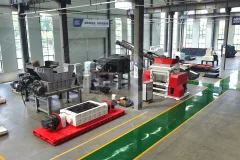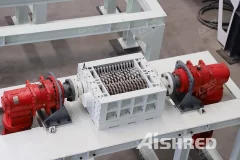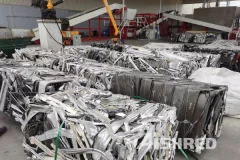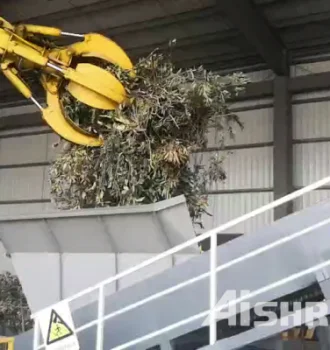Proposal for Copper and Aluminum Scrap Shredder for Large Parts (Engine Parts, Wheel Rims, etc.)
2024-11-30Today a famous South African metal recycling company asked us for a 6 ton/hour copper and aluminum shredder, to crush big parts, like engine part, wheel rim and etc., the volume of the material is reduced by at least half. Based on the requirements, we have tailored the following proposal for our customer.Recommended Shredding Solution: GD8 Double-Shaft ShredderBased on your specific needs, we recommend our GD8 Double-Shaft Intelligent Shredder. This shredder is designed to process large and tough materials like engine parts and wheel rims, making it ideal for your copper and aluminum scrap recycling requirements.Key Features of the GD8 Double-Shaft Shredder:Motor Power: 2 x 55kW or 2 x 75kW (customized to meet your throughput needs).Cutting System: High-strength NiCrMo alloyed steel cutters, perfect for shredding large, tough non-ferrous materials.Hydraulic Feeding System: Ensures smooth operation by efficiently pushing large parts into the shredder.Control System: Integrated with the GEP intelligent


Scrap Aluminum Hammer Shredding Production Line Production line introductionScrap Aluminum Shredder is a kind of shredding equipment used to process scrap aluminum, which is mainly used for the shredding and sorting operation of machined aluminum, raw aluminum, aluminum alloy and broken aluminum. With advanced technology, large processing range and high production efficiency, the production line can fully separate iron, aluminum and plastic, and the purity can reach more than 99%, and the production process is noiseless and non-polluting, which is the mainstream equipment for scrap aluminum recycling at present. Process FlowScrap aluminum shredding and sorting equipment consists of scrap aluminum shredder, magnetic separator, trommel screen, eddy current sorter and dust collector. The material is sent into the aluminum shredder for fine shredding through the conveyor, and the shredded material is separated from iron by the magnetic separator, and then it enters into the trommel screen to separate the


The non-ferrous metal recycling industry in Ireland is a dynamic sector focusing on the recovery of metals such as aluminum, brass, copper, and precious metals from various sources, including electronic scrap. With diverse needs ranging from large-scale corporate recyclers to smaller operations recovering valuable metals from electronic components, selecting the right shredding equipment is crucial. GEP ECOTECH offers a comprehensive range of non-ferrous scrap metal shredders designed to meet these varied requirements effectively.GEP ECOTECH Shredding SolutionsGEP ECOTECH is renowned for its extensive lineup of non-ferrous metal shredders, providing versatile and efficient solutions for metal recyclers. Their equipment is designed to handle a broad spectrum of metal recycling applications with ease and precision.GEP Dual-Shaft ShredderVersatility: Ideal for shredding bales or drums, these models are highly tolerant of tramp metals, making them suitable for a variety of non-ferrous scrap materials.Power

4-Shaft Shredder for Aluminum Castings
2024-07-31In the realm of industrial recycling, the 4-shaft shredder has emerged as a critical tool for processing aluminum castings efficiently and sustainably. Designed to handle robust materials with precision and reliability, this shredder type plays a pivotal role in maximizing material recovery and minimizing waste in aluminum casting recycling processes.The 4-shaft shredder is characterized by its robust construction and advanced shredding mechanism, which includes four interlocking shafts equipped with sturdy blades or cutters. Here are the notable features of a 4-shaft shredder:Shredding Capability: The four shafts operate in sync to provide powerful shredding action, effectively reducing aluminum castings into smaller, manageable pieces. This design ensures thorough processing and uniform shred sizes, essential for downstream recycling operations.Material Handling: Designed specifically for handling aluminum castings, the 4-shaft shredder can efficiently process bulky and irregularly shaped pieces without

The price of an aluminum blocks shredding machine can vary widely depending on several factors, including the machine's specifications, brand, capacity, and whether it's new or used. Additionally, prices can vary from one region or country to another. To give you a rough estimate, I can provide a general price range based on common types of industrial shredders:Small-Scale Shredders (Low Capacity)Small shredders designed for low-capacity operations can range from $1,000 to $10,000 or more, depending on their features and quality.Medium-Scale Shredders (Moderate Capacity)Medium-sized shredders with a higher capacity typically range from $10,000 to $20,000, again depending on various factors.Large-Scale Shredders (High Capacity)Large industrial shredders capable of processing substantial amounts of material can cost anywhere from $20,000 to $100,000 or more, depending on capacity and features.GEP ECOTECH Single Shaft Aluminum Blocks Shredding Machine Specialized Shredders (Custom-Built)Custom-built shredding


UBC stands for Used Beverage Cans, and as the name suggests, it primarily consists of aluminum beverage containers that have been consumed and discarded by consumers. These cans are commonly used for packaging various beverages, including cocal, soda, beer, and energy drinks. UBC originates from households, commercial establishments, and public spaces, where people consume these beverages and then empty cans are collected by recycler.The recycling value of UBC is substantial and multifaceted. Aluminum, the primary metal in UBC, is highly sought after in the recycling industry for several reasons. Firstly, recycling aluminum requires significantly less energy compared to producing new aluminum from raw materials. This energy efficiency translates into reduced greenhouse gas emissions and conserves valuable resources. Secondly, aluminum retains its quality and properties even after multiple recycling cycles, making it an ideal material for sustainable manufacturing. Lastly, the recycling of UBC reduces the


The recycling of PVC window frames plays a crucial role in sustainable waste management, with a focus on resource recovery and environmental conservation. This article explores the efficient process of shredding PVC window frames to extract valuable steel and aluminum, contributing to a more circular and eco-friendly approach to materials management.Shredding ProcessThe initial step in recycling PVC window frames involves the use of advanced shredding equipment. A high-capacity industrial shredder is employed to break down the window frames into smaller, more manageable pieces. The shredding process not only reduces the volume of materials but also prepares them for subsequent separation and extraction stages.Steel Extraction:Once the PVC window frames are shredded, the material undergoes a separation process to extract steel components. This is often achieved through the use of magnetic separators, which attract and isolate ferrous metals like steel. The extracted steel components can then be sent to steel

Aluminium Profile Shredder Price
2024-01-10Aluminium profile shredders play a pivotal role in recycling operations, breaking down robust aluminium profiles into smaller fragments for repurposing. Their prices vary due to multiple factors that determine their cost.Common Models and Approximate Prices1. Model A - Medium Capacity ShredderPrice Range: $30,000 - $80,000Suitable for mid-sized recycling facilities with moderate throughput requirements.2. Model B - High-Capacity ShredderPrice Range: $80,000 - $150,000Designed for larger-scale operations, capable of processing high volumes of aluminium profiles.3. Model C - Specialized Shredder with AutomationPrice Range: $150,000 - $300,000Equipped with advanced automation and safety features for specialized recycling needs.Factors Influencing Aluminium Profile Shredder PricesMachine Specifications: Shredder capacity, power, and design greatly impact pricing. High-capacity machines with advanced features usually cost more.Technology and Features: Shredders with advanced automation, safety features, and

Two Shaft Aluminium Beverage Can Shredder
2023-10-21A two-shaft aluminum beverage can shredder is an industrial machine designed specifically for shredding and reducing the size of aluminum beverage cans. These shredders play a crucial role in recycling operations, as they help process aluminum cans into smaller particles for further recycling and material recovery.Video of Twin-Shaft Shredder Shredding Aluminum CansKey Features of a Two-Shaft Aluminium Beverage Can ShredderDual Shafts: As the name suggests, a two-shaft shredder has two parallel shafts equipped with sharp blades or cutting discs. This design enhances the efficiency of shredding and ensures a more thorough reduction of material.Cutting Blades: The cutting blades on each shaft are strategically positioned to cut through aluminum cans effectively. The blades are designed to withstand the abrasive nature of metal shredding.High Torque and Power: Two-shaft shredders typically have high torque and power to handle the tough and rigid nature of aluminum cans. This is important for achieving efficient


Aluminum scrap is a waste generated during the production of aluminum products, and its effective treatment is crucial for resource recovery and environmental protection. In the aluminum chip pretreatment stage, the dual-shaft shredder shows its unique advantages and becomes an efficient and stable aluminum chip processing tool.Structure and working principleStructural design: The aluminum chip twin-shaft shredder consists of two parallel rotating main shafts, each of which is equipped with a strong shredding blade. This dual-axis design allows aluminum chips to be shredded in multiple directions and evenly in two interacting shredding systems.Working principle: During operation, aluminum chips enter the dual-shaft shredder through the feed port and are sheared and shredded by the blades on the dual shafts. Due to the relative motion of the two shafts, the aluminum chips are shredded multiple times between the two shafts, thereby achieving an efficient and detailed shredding effect.Applicability and advantage


Compressed Aluminum Scrap Shredder Machine
2023-07-18As the most widely used and valuable metal in the world, aluminum plays a crucial role in industrial production and daily life. Scrap aluminum recycling is a highly profitable and well-established industry. Typically, scrap aluminum products are packaged (to save storage and transportation costs) and transported to the smelter. The smelter needs to preprocess the scrap metal before melting it. The primary processes involved are shredding and sorting, aiming to reduce energy consumption during melting and separate other metals. The picture above showcases an exemplary aluminum scrap shredding and sorting system that we recently implemented in Mexico. This comprehensive system includes cutting-edge equipment and machinery designed to optimize the recycling process. Among the components featured in this system are the AIShred GC12 pre-shredder, AIShred GD10 double-shaft shear shredder, magnetic separator, trommel screen, and belt conveyor. The AIShred GC12 pre-shredder serves as the initial stage of the process


Industrial Scrap Metal Shredder
2022-05-12Metal is one of the most widely used industrial materials, and it can be recycled many times after use without loss of quality. compared with the costs of manufacturing metal elements from ore, the use of recycled materials for these purposes provides a significant economic effect. We offer high-quality shredders for scrap metal. They are the most important equipment for recycling metal products, They are able to shred both light (aluminum, magnesium, copper, nickel) and harder metals (iron, zirconium, titanium, steel, etc.). AIShred's industrial shredders can process the following metal wastes:Scrap Car BodyScrap Metal DrumScrap Metal ProfilesScrap Aluminum AlloyScrap Metal BriquettePunching, Sheet metal, Milling WasteWEEE As leading metal shredder manufacturers, we offer an complete range of scrap metal shredding plants. Whether you need pre-shredders, shear shredders or separation technologies, all our equipment guarantee the highest results in end product cleanliness and purity.

Recycling aluminum profile waste - it is a profitable and efficient activity. The aluminum profile is often used in construction and decoration of houses, as this material has a long service life and an attractive appearance. However, any material needs to be replaced and the aluminum profile is no exception. Recycled aluminum is a high demand product and its characteristics are not inferior to the primary material, and much less resources are spent on remelting. Optimizing the loading of furnaces for the processing of waste aluminum profile material requires proper preparation of the material. The aluminum profile is less and less common in its pure form. Since aluminum has poor sound insulation and thermal conductivity characteristics, it is very often combined with carved or plastic. This improves the consumer properties of the product, but complicates processing. An aluminum profile with inserts cannot simply be pressed to increase density. In this case, for the processing of aluminum profile waste, we



